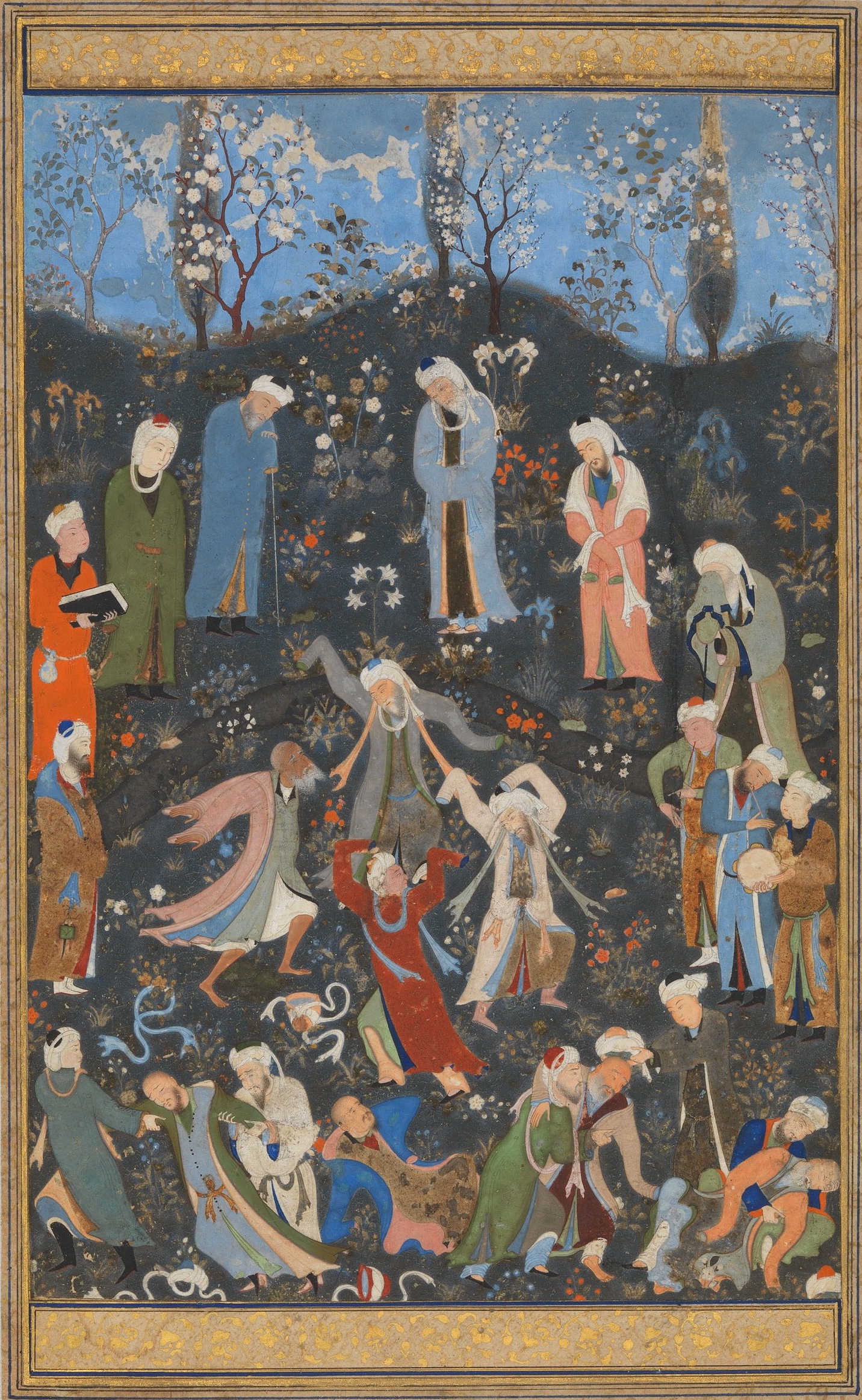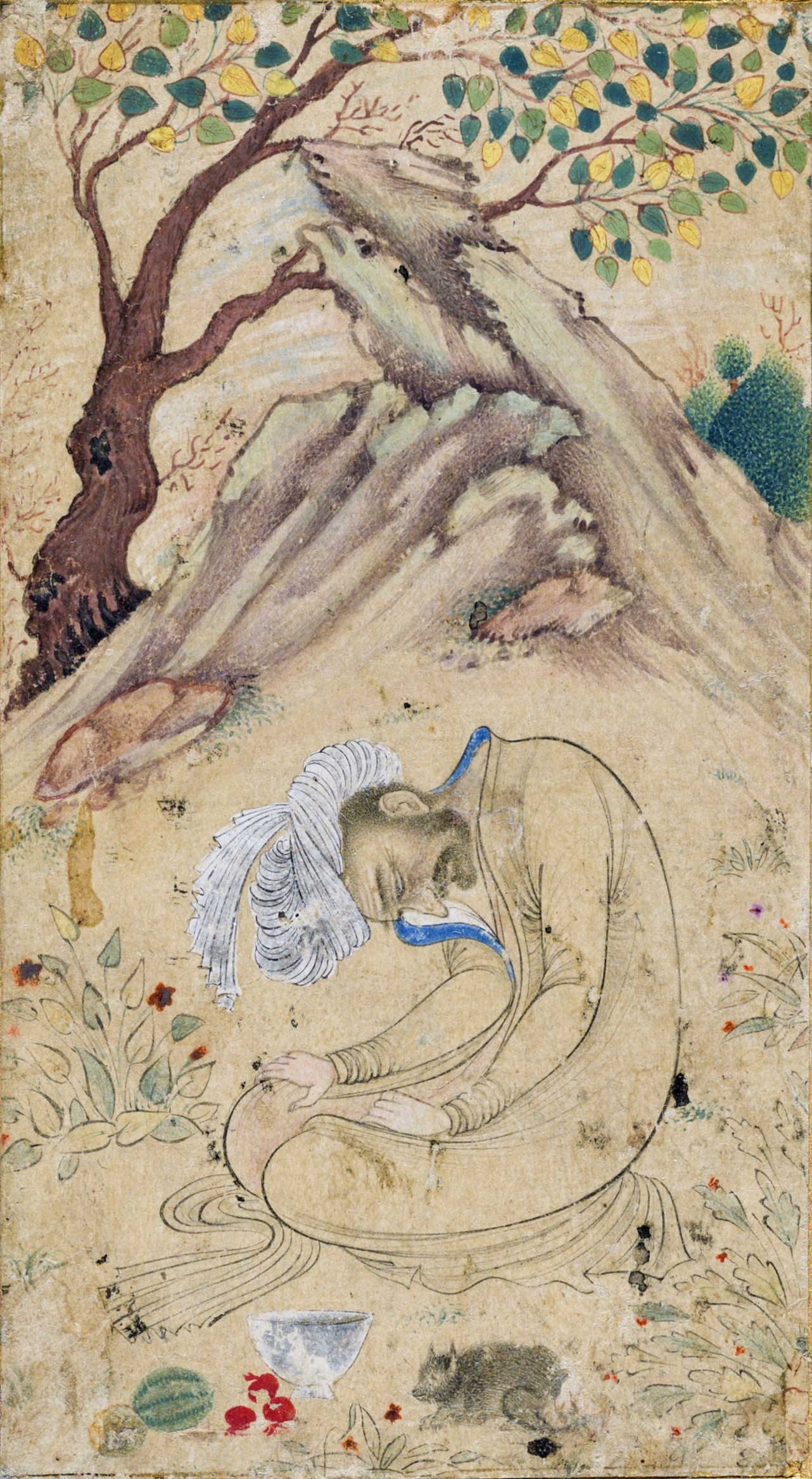|
Al-Qushayri
'Abd al-Karīm ibn Hawazin Abū al-Qāsim Banu Qushayr, al-Qushayrī al-Naysābūrī ( fa, , ar, عبد الكريم بن هوازن بن عبد الملك بن طلحة أبو القاسم القشيري; 986 – 30 December 1072) was an Arabs, Arab Scholar, Muslim scholar and theologian known for his works on Sufism. He was born in Nishapur which is in Khorasan Province in Iran. This region was widely known as a center of Islamic civilization up to the 13th Century CE. He was the grandfather of the scholar Abd al-Ghafir al-Farsi, a contemporary of Al-Ghazali, Al Ghazali. Biography Al Qushayri was born into a privileged Arabs, Arab family from among the Banu Qushayr who had settled near Nishapur. As a young man he received the education of a country squire of the time: adab, the Arabic language, chivalry and weaponry (istiʿmāl al-silāḥ), but that all changed when he journeyed to the city of Nishapur and was introduced to the Sufi shaykh Abū ʿAlī al-Daqqāq. Daqqāq l ... [...More Info...] [...Related Items...] OR: [Wikipedia] [Google] [Baidu] |
Al-Risala Al-Qushayriyya
Al-Risala al-Qushayriyya fi 'Ilm al-Tasawwuf ( ar, الرسالة القشيرية في علم التصوف, lit=The Qushayriyyan Epistle on the Science of Sufism), mostly known as al-Risala al-Qushayriyya (The Treatise of al-Qushayri), is one of the early complete manuals of the science of Sufism (tasawwuf in Arabic), written by the Shafi'i-Ash'ari scholar Abu al-Qasim al-Qushayri (d. 465/1074). It was written in 438/1045–6 and has been published in several editions and translated in various languages, including English, French, German, Persian, Turkish, and Urdu. It became the most widely disseminated handbook of Sufism in the Islamic world. Purpose and authorship Al-Qushayri's goal was to show the compatibility between mystical teaching and mainstream Sunni Islam. The purpose of authoring the book was to provide a solid structure for Sufism, along with its terminology and principles, and to demonstrate the conformity of Sufi beliefs and practices with the norms of the Sha ... [...More Info...] [...Related Items...] OR: [Wikipedia] [Google] [Baidu] |
Abd Al-Ghafir Al-Farsi
Abd al-Ghafir ibn Ismail ibn Abd al-Ghafir ibn Muhammad al-Farsi ( ar, عبد الغافر بن اسماعيل بن عبد الغافر بن محمد الفارسي) was a Persian scholar of Arabic, history and hadith from Nishapur. He was a student, contemporary, and first biographer of Al-Ghazali. He was also the grandson of Al-Qushayri, the author of Qushayri message. Works Amongst the most famous works of Abd al-Ghafir al-Farsi are: * Al-Bayan al-Tareekh Nishapur (The History of Nishapur) * Al-Mufhim of Sahih-Muslim Ibn Kathir's Bidaya wal Nihaya, Under the description of Abd-Ghafir al-Farsi * Majma al-Gharaaib Fi Gharib al-Hadith (The book was printed and verified by Abdullah bin Nasser bin Muhammad Al-Qarni (Umm Al-Qura University - 1409 AH / 1989 AD)) Death Abd al-Ghafir al-Farsi died in 529/1135 in Nishapur. See also * List of Ash'aris and Maturidis The list of Ash'aris and Maturidis includes prominent adherents of the Ash'ari and Maturidi schools of thought. T ... [...More Info...] [...Related Items...] OR: [Wikipedia] [Google] [Baidu] |
Tasawwuf
Sufism ( ar, ''aṣ-ṣūfiyya''), also known as Tasawwuf ( ''at-taṣawwuf''), is a mystic body of religious practice, found mainly within Sunni Islam but also within Shia Islam, which is characterized by a focus on Islamic spirituality, ritualism, asceticism and esotericism. It has been variously defined as "Islamic mysticism",Martin Lings, ''What is Sufism?'' (Lahore: Suhail Academy, 2005; first imp. 1983, second imp. 1999), p.15 "the mystical expression of Islamic faith", "the inward dimension of Islam", "the phenomenon of mysticism within Islam", the "main manifestation and the most important and central crystallization" of mystical practice in Islam, and "the interiorization and intensification of Islamic faith and practice". Practitioners of Sufism are referred to as "Sufis" (from , ), and historically typically belonged to "orders" known as (pl. ) – congregations formed around a grand who would be the last in a chain of successive teachers linking back to Muh ... [...More Info...] [...Related Items...] OR: [Wikipedia] [Google] [Baidu] |
Sufi
Sufism ( ar, ''aṣ-ṣūfiyya''), also known as Tasawwuf ( ''at-taṣawwuf''), is a mystic body of religious practice, found mainly within Sunni Islam but also within Shia Islam, which is characterized by a focus on Islamic spirituality, ritualism, Asceticism#Islam, asceticism and esotericism. It has been variously defined as "Islamic mysticism",Martin Lings, ''What is Sufism?'' (Lahore: Suhail Academy, 2005; first imp. 1983, second imp. 1999), p.15 "the mystical expression of Islamic faith", "the inward dimension of Islam", "the phenomenon of mysticism within Islam", the "main manifestation and the most important and central crystallization" of mystical practice in Islam, and "the interiorization and intensification of Islamic faith and practice". Practitioners of Sufism are referred to as "Sufis" (from , ), and historically typically belonged to "orders" known as (pl. ) – congregations formed around a grand who would be the last in a Silsilah, chain of successive teac ... [...More Info...] [...Related Items...] OR: [Wikipedia] [Google] [Baidu] |
Sufism
Sufism ( ar, ''aṣ-ṣūfiyya''), also known as Tasawwuf ( ''at-taṣawwuf''), is a mystic body of religious practice, found mainly within Sunni Islam but also within Shia Islam, which is characterized by a focus on Islamic spirituality, ritualism, asceticism and esotericism. It has been variously defined as "Islamic mysticism",Martin Lings, ''What is Sufism?'' (Lahore: Suhail Academy, 2005; first imp. 1983, second imp. 1999), p.15 "the mystical expression of Islamic faith", "the inward dimension of Islam", "the phenomenon of mysticism within Islam", the "main manifestation and the most important and central crystallization" of mystical practice in Islam, and "the interiorization and intensification of Islamic faith and practice". Practitioners of Sufism are referred to as "Sufis" (from , ), and historically typically belonged to "orders" known as (pl. ) – congregations formed around a grand who would be the last in a chain of successive teachers linking back to ... [...More Info...] [...Related Items...] OR: [Wikipedia] [Google] [Baidu] |
Islam
Islam (; ar, ۘالِإسلَام, , ) is an Abrahamic religions, Abrahamic Monotheism#Islam, monotheistic religion centred primarily around the Quran, a religious text considered by Muslims to be the direct word of God in Islam, God (or ''Allah'') as it was revealed to Muhammad, the Muhammad in Islam, main and final Islamic prophet.Peters, F. E. 2009. "Allāh." In , edited by J. L. Esposito. Oxford: Oxford University Press. . (See alsoquick reference) "[T]he Muslims' understanding of Allāh is based...on the Qurʿān's public witness. Allāh is Unique, the Creator, Sovereign, and Judge of mankind. It is Allāh who directs the universe through his direct action on nature and who has guided human history through his prophets, Abraham, with whom he made his covenant, Moses/Moosa, Jesus/Eesa, and Muḥammad, through all of whom he founded his chosen communities, the 'Peoples of the Book.'" It is the Major religious groups, world's second-largest religion behind Christianity, w ... [...More Info...] [...Related Items...] OR: [Wikipedia] [Google] [Baidu] |
Iran
Iran, officially the Islamic Republic of Iran, and also called Persia, is a country located in Western Asia. It is bordered by Iraq and Turkey to the west, by Azerbaijan and Armenia to the northwest, by the Caspian Sea and Turkmenistan to the north, by Afghanistan and Pakistan to the east, and by the Gulf of Oman and the Persian Gulf to the south. It covers an area of , making it the 17th-largest country. Iran has a population of 86 million, making it the 17th-most populous country in the world, and the second-largest in the Middle East. Its largest cities, in descending order, are the capital Tehran, Mashhad, Isfahan, Karaj, Shiraz, and Tabriz. The country is home to one of the world's oldest civilizations, beginning with the formation of the Elamite kingdoms in the fourth millennium BC. It was first unified by the Medes, an ancient Iranian people, in the seventh century BC, and reached its territorial height in the sixth century BC, when Cyrus the Great f ... [...More Info...] [...Related Items...] OR: [Wikipedia] [Google] [Baidu] |
Al-Ghazali
Al-Ghazali ( – 19 December 1111; ), full name (), and known in Persian-speaking countries as Imam Muhammad-i Ghazali (Persian: امام محمد غزالی) or in Medieval Europe by the Latinized as Algazelus or Algazel, was a Persian polymath. He is known as one of the most prominent and influential philosophers, theologians, jurists, logicians and mystics of the Islamic Golden Age. Ludwig W. Adamec (2009), ''Historical Dictionary of Islam'', p.109. Scarecrow Press. . He is considered to be the 5th century's '' mujaddid'',William Montgomery Watt, ''Al-Ghazali: The Muslim Intellectual'', p. 180. Edinburgh: Edinburgh University Press, 1963. a renewer of the faith, who, according to the prophetic hadith, appears once every 100 years to restore the faith of the Islamic community. His works were so highly acclaimed by his contemporaries that al-Ghazali was awarded the honorific title "Proof of Islam" ('' Ḥujjat al-Islām'').Hunt Janin, ''The Pursuit of Learning in the I ... [...More Info...] [...Related Items...] OR: [Wikipedia] [Google] [Baidu] |
Pilgrimage
A pilgrimage is a journey, often into an unknown or foreign place, where a person goes in search of new or expanded meaning about their self, others, nature, or a higher good, through the experience. It can lead to a personal transformation, after which the pilgrim returns to their daily life. Background Pilgrimages frequently involve a journey or search of moral or spiritual significance. Typically, it is a journey to a shrine or other location of importance to a person's beliefs and faith, although sometimes it can be a metaphorical journey into someone's own beliefs. Many religions attach spiritual importance to particular places: the place of birth or death of founders or saints, or to the place of their "calling" or spiritual awakening, or of their connection (visual or verbal) with the divine, to locations where miracles were performed or witnessed, or locations where a deity is said to live or be "housed", or any site that is seen to have special spiritual power ... [...More Info...] [...Related Items...] OR: [Wikipedia] [Google] [Baidu] |
Madrasa
Madrasa (, also , ; Arabic: مدرسة , pl. , ) is the Arabic word for any type of educational institution, secular or religious (of any religion), whether for elementary instruction or higher learning. The word is variously transliterated ''Madrasah arifah'', ''medresa'', ''madrassa'', ''madraza'', ''medrese'', etc. In countries outside the Arab world, the word usually refers to a specific type of religious school or college for the study of the religion of Islam, though this may not be the only subject studied. In an architectural and historical context, the term generally refers to a particular kind of institution in the historic Muslim world which primarily taught Islamic law and jurisprudence (''fiqh''), as well as other subjects on occasion. The origin of this type of institution is widely credited to Nizam al-Mulk, a vizier under the Seljuks in the 11th century, who was responsible for building the first network of official madrasas in Iran, Mesopotamia, and Khorasan. F ... [...More Info...] [...Related Items...] OR: [Wikipedia] [Google] [Baidu] |
Al-Juwayni
Dhia' ul-Dīn 'Abd al-Malik ibn Yūsuf al-Juwaynī al-Shafi'ī ( fa, امام الحرمین ضیاءالدین عبدالملک ابن یوسف جوینی شافعی, 17 February 102820 August 1085; 419–478 AH) was a Persian Sunni Shafi'i jurist and mutakallim theologian. His name is commonly abbreviated as Al-Juwayni; he is also commonly referred to as ''Imam al Haramayn'',M. M. Sharif, A History of Muslim Philosophy, 1.242. meaning "leading master of the two holy cities", that is, Mecca and Medina. Biography Al-Juwayni was born on 17 February 1028 in a village on the outskirts of Naysabur called Bushtaniqan in Iran,Al-Juwayni, Yusef. A Guide to the Conclusive Proofs for the Principles of Belief. 1 ed. Eissa S. Muhammad. The Center for Muslim Contribution to Civilization, 2000 Al-Juwayni was a prominent Muslim scholar known for his gifted intellect in Islamic legal matters. Al-Juwayni was born into a family of legal study. His father, Abu Muhammad 'Abdallah b. Yusef a ... [...More Info...] [...Related Items...] OR: [Wikipedia] [Google] [Baidu] |



.jpg)


